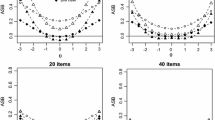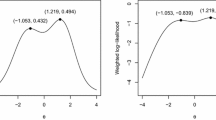Abstract
Estimating ability parameters in latent trait models in general, and in the Rasch model in particular is almost always hampered by noise in the data. This noise can be caused by guessing, inattention to easy questions, and other factors which are unrelated to ability. In this study several alternative formulations which attempt to deal with these problems without a reparameterization are tested through a Monte Carlo simulation. It was found that although no one of the tested schemes is uniformly superior to all others, a modified jackknife stood out as the best one in general, it was also super efficient (more efficient than the asymptotically optimal estimator) for tests with forty or fewer items. It is proposed that this sort of jackknifing scheme for estimating ability be considered for practical work.
Similar content being viewed by others
References notes
Lord, F.Small N Justifies Rasch methods. Paper presented at the Third Conference on Computerized Adaptive Testing, Minneapolis, Minnesota, 1979.
Novick, M. R. Personal communication at the third Conference on Computerized Adaptive Testing, Minneapolis, Minnesota, 1979.
Ree, M. J. & Jensen, H. E.Effects of Sample size in the estimation of item parameters. Paper presented at the Third Conference on Computerized Adaptive Testing, Minneapolis, Minnesota, 1979.
Wright, B. D. & R. J. Mead.Analysis of residuals. Unpublished manuscript, 1976.
Lewis, C.The countback method (Res. Bul. 70-30). Princeton, NJ: Educational Testing Service, 1970.
Martin-Löf, P.Exact tests, confidence regions and estimates. Proceedings of conference on fundamental questions on statistical inference (Memoirs No. 1). Aarhus. Denmark: Department of Theoretical Statistics, Institute of Mathematics, University of Aarhus. 1974.
Wright, B. D. & Mead, R. J.The use of measurement models in the definition and application of social science variables (Tech. Rep. DAHC 19-76-6-0011). Arlington, VA: U.S. Army Research Institute, 1977.
References
Andersen, E. B. A goodness of fit test for the Rasch model.Psychometrika, 1973,38, 123–140.
Andrews, D. F., Bickel, P. J., Hampel, F. R., Huber, P. J., Rogers, W. H. & Tukey, J. W.Robust estimates of location. Princeton, N.J.: Princeton University Press, 1972.
Bock, R. D. Estimating item parameters and latent trait ability when responses are scored in two or more nominal categories.Psychometrika, 1972,37, 29–51.
Bock, R. D. & Wood R. Test Theory.Annual Review of Psychology, 1971,22, 193–224.
Fischer, G. H.Einfurung in die Theorie psychologischer Tests. Grundlagen und Anwendungen. Bern: Huber, 1974.
Hambleton, R. K., Swaminathan, H., Cook, L. L., Eignor, D. R. & Gifford, J. A. Developments in latent trait theory: Models, technical issues, and applications.Review of Educational Research, 1978,48, 467–510.
Kendall, M. G. & Stuart, A.The Advanced Theory of Statistics (Volume 2). Hafner: New York, 1961.
Lord, F. M. & Novick, M. R.Statistical theories of metal test scores. Addison-Wesley: Reading, Mass, 1968.
Perline, R., Wright, B. D. & Wainer, H. The Rasch model as additive conjoint measurement.Applied Psychological Measurement, 1979,3, 237–256.
Quenouille, M. Notes on bias in estimation.Biometrika, 1956,43, 353–360.
Rasch, G.Probabilistic models for some intelligence and attainment tests. Copenhagen: The Danish Institute for Educational Research, 1960.
Ramsay, J. O. A comparative study of several robust estimates of slope, intercept, and scale in linear regression.Journal of the American Statistical Association, 1977,72, 608–615.
Thissen, D. M. Information in wrong responses to the raven progressive matrices.Journal of Educational Measurement, 1976,13, 201–214.
Tukey, J. W. Bias and confidence in not quite large samples.Annals of Mathematical Statistics, 1958,29, 614. (Abstract)
Tukey, J. W.Exploratory Data Analysis. Addison-Wesley: Reading, Mass, 1977.
Wainer, H., Morgan, A. & Gustafsson, J-E. A review of estimations procedures for the Rasch model with an eye toward longish tests.Journal of Educational Statistics, 1980,5, 35–64.
Wright, B. D. Sample-free test calibration and person measurement.Proceedings of the 1967 Invitational Conference on Testing Problems. Princeton, N.J.: Educational Testing Service, 1968, 85–101.
Wright, B. D. Solving measurement problems with the Rasch model.Journal of Educational Measurement, 1977,14, 97–116.
Wright, B. D. & Panchapakesan, N. A procedure for sample free item analysis.Educational and Psychological Measurement, 1969,29, 23–48.
Wright, B. D. & Stone, M. H.Best Test Design, MESA Press: Chicago, 1979.
Author information
Authors and Affiliations
Additional information
This research was funded through a grant from the Law Enforcement Assistance Administration (78-NI-AX-0047) to the Bureau of Social Science Research, Howard Wainer, Principal Investigator. We would like to thank Ronald Mead, Anne Morgan and James Ramsay for kind, generous, and invaluable help at various stages of the project.
Rights and permissions
About this article
Cite this article
Wainer, H., Wright, B.D. Robust estimation of ability in the Rasch model. Psychometrika 45, 373–391 (1980). https://doi.org/10.1007/BF02293910
Received:
Revised:
Issue Date:
DOI: https://doi.org/10.1007/BF02293910




